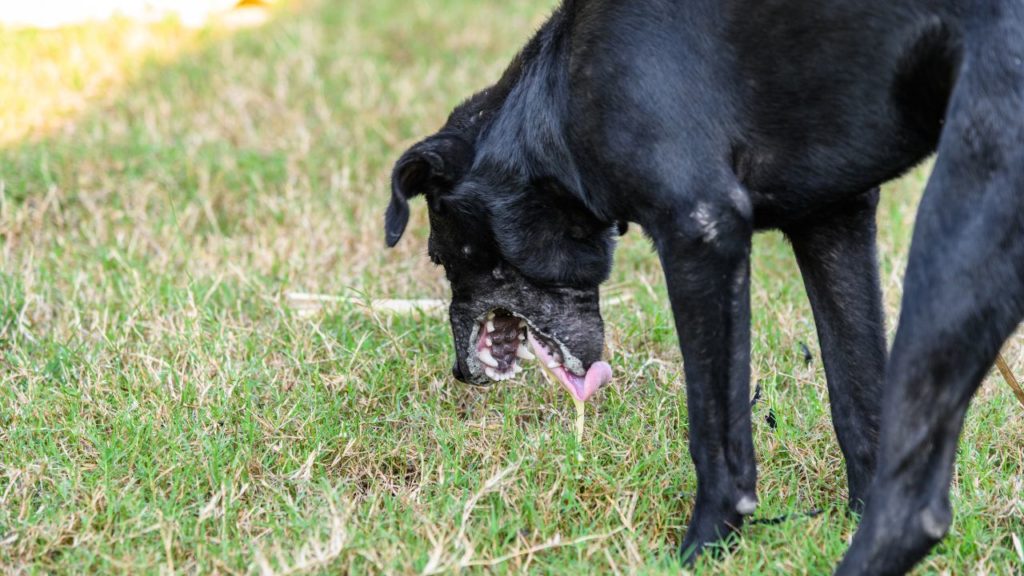Blood in your dog’s stool is a reason to pay attention, but not to panic. Causes can range from minor one-time ailments to something much more serious, including cancer in your dog’s gastrointestinal tract. Thankfully, your dog’s medical history, context clues, and diagnostic procedures can readily help your veterinarian determine the most likely cause.
Key Takeaways
- One instance of bloody stool in dogs is not an emergency. If the dog has other symptoms of illness or the bloody stool persists, they should see a vet. Vomiting and diarrhea is an emergency.
- If your dog’s poop has blood in it, pick it up in a bag and take it to your vet’s office to be checked for parasites. If your dog has other symptoms or chronic health issues, they should be examined by a veterinarian.
- Bright red blood in dog stool may go away on its own. Dark, black blood is more concerning.
- If your dog is pooping blood but acting fine, they may have a parasite infection or have eaten something they shouldn’t have.
- The most common cause of bloody diarrhea in dogs is probably intestinal parasites.
Identifying Blood in Dog Stool
Blood in your dog’s stool happens when a source of blood discharges from their gastrointestinal tract.1 It can vary in color from bright red to almost black,2 and can range from just a few droplets to a noticeably streaky appearance.3 Blood can be found on the surface of the stool or mixed in.3
There may also be very little fecal matter accompanying the blood at all, which may indicate that your dog has not been eating for some time and has an empty stomach.4
Leading up to seeing blood in their stool, you may see your dog straining to defecate or defecating more frequently.3
You may also notice your dog behaving in a more lethargic manner, or they could display some additional troubling symptoms, like vomiting.2
One of the most frustrating aspects of observing blood in your dog’s stool is that it tells you that something is definitely wrong, but does little to tell you what is wrong.1
Why Blood in Dog Stool Happens
Blood in your dog’s stool can happen because of completely benign reasons, something more serious going on, or even as a side effect of certain medications.2
The appearance of the blood in your dog’s stool is a good starting point to hint at what’s going on.
Bright Red Blood in Dog Stool
Bright red blood in your dog’s stool is called hematochezia.2 The brighter color usually means that blood loss is restricted to the lower portion of your dog’s digestive tract, like their colon or rectum.3
In addition to being bright red in appearance, you dog’s feces may be loose and watery or fully formed, otherwise discolored, or normal looking.3 Causes can range from mild to severe, but typically aren’t dangerous.2
If you observe hematochezia once, and not accompanied by any other concerning symptoms, then there’s likely no reason to suspect a more serious issue.3
However, if bright red blood repeatedly appears, or happens in conjunction with additional symptoms, then it may be reflective of a more dire situation.3 If your dog poops liquid blood, they should see a veterinarian as soon as possible.
There are near countless potential causes of hematochezia. You dog may have…
- experienced an injury that induced bleeding.2
- gotten a parasite.2
- swallowed some sort of non-digestible material, such as plastic from a chewed dog toy or bone shards from a fish.3
- allergies or a dietary intolerance to a newly introduced food.3
- Irritable Bowel Disorder or Syndrome.2
- developed an infection in their anal glands.2
- parvovirus.2 We generally think of parvovirus as only affecting puppies, but any dogs that aren’t vaccinated against it can suffer from the virus.
- been exposed to an environment or stimulus that has caused stress and anxiety.5
- a tumor in their lower bowels.3
- ingested a toxic or poisonous substance.2
Black Stool
Dark red or black blood is a cause for greater concern and is usually a sign that something is seriously wrong.2 Blood of this hue is clinically referred to as melena, and owes its coloring to the fact that the blood has already been digested prior to defecation.1,2,3 It may also have a “tarry” appearance or a jelly-like texture.1
There are fewer causes of melena, but they are almost always more serious than causes of hematochezia.2 Your dog may have internal bleeding in the stomach or upper gastrointestinal tract from swallowing a foreign object.2 They could be in a state of liver or kidney failure or even suffering from pancreatitis.2
Lastly, and arguably more concerning for dog owners, they could have a tumor.2 Unlike tumors that cause hematochezia, tumors that cause melena are more likely to be malignant.2
Bloody Stool in Dogs with Cancer
If your dog has already been diagnosed with cancer, bloody stools can be a side effect of their treatment.
For example, chemotherapy is hard on your dog’s intestinal system and can lead to blood loss.6 Symptoms usually start one to five days after treatment and can last for three days or more.6 About 5% of dogs undergoing chemotherapy will experience bloody stools that last for more than 48 hours.6
Genetic Risks
Polyps are a type of tumor that are common in the gastrointestinal tracts of Jack Russell Terriers with a specific genetic mutation.9 In a study on 46 gastrointestinal polyps discovered in 21 Jack Russell Terriers, 93.5% of those polyps were determined to be adenomas or adenocarcinomas.9
If you have a JRT, make a point of checking out their stool on a regular basis. Blood in the stool could be an early indicator of a polyp.
What to Do
If you see blood in your dog’s stool, the first step is to take a deep breath, and not panic.2
Next, make sure that what you’re seeing is actually blood.8 Has your dog ingested food with red coloring? Is it possible they could have eaten a non-food item that’s red, like a crayon?
If you suspect that blood is the substance in your dog’s stool, take a photograph of it, so you can show your veterinarian. You should also bag the stool. Call your vet for advice or schedule an appointment and take the sample with you.2
In the meantime, reflect on the last couple of days with your dog.1
- What medications are they on? Check the inserts and see if this is a side effect.
- How has their appetite been?
- Have their activity levels been normal?
- What has their overall temperament been like?
Awareness of any abnormal behavior in your dog the last few days can be helpful in determining the cause of the blood in their stool, as well as how long your dog may have been dealing with the issue.
You know your dog best and can look for other signs that they aren’t feeling great.1 Take a look at their gums. They should be a salmon color if your dog is healthy, but may be white or pale pink if your dog’s body is battling something.4
When to Call Your Vet
You should call your vet for any occurrence of blood in your dog’s stool,3 but keep in mind that a one-time occurrence of bright red blood is likely temporary and not life threatening.2 If there is blood in your dog’s stool but they are acting normal, this is not an emergency.
Any sign of blood in your dog’s stool indicates that something is amiss,1 but the degree of severity can vastly range. Calling your vet can at minimum give you peace of mind.
Dark red to black blood that is “tarry” in appearance or has accompanying symptoms, like vomiting or difficulty breathing, indicate that you should take your dog to the vet as soon as possible.1,2 Vomiting and diarrhea at the same time is an emergency, as dogs can quickly get dehydrated.
You should also call your vet if your dog has recently had chemotherapy treatment, especially if blood has been present in their stools for longer than 48 hours.6
Keep in mind that it may be difficult to gauge how long your dog has been dealing with melena because its dark coloring helps it blend in with your dog’s stool.1 You may want to take this into consideration when explaining the timeline of symptom onset to your veterinarian.
Things that Help
If you do call your vet, be ready with the information they need to make a diagnosis and treatment plan. They may ask you to describe what the stool and blood looks like over the phone (you can also snap a picture and text or email it to the vet) and if your dog has had any intestinal blockages, physical obstructions, ulcers, or tumors in the past.8
Figuring Out the Cause
The treatment that your dog receives will be highly dependent on the diagnosis and their individual needs.3 Your vet will start by confirming that blood is actually present in your dog’s stool. If they have access to a stool sample from your dog, they’ll also likely check for parasites to rule them out as a cause.
Your veterinarian will palpate the abdomen to check for any obstruction or pain. They’ll also check heart function, look for symptoms of blood loss, and likely due to a skin test to determine hydration levels as well.8
Depending on your dog’s symptoms and medical history, your veterinarian may do some additional tests. Diagnostics may include:
- Packed cell volume (PCV) or hematocrit (HCT) measurement to determine the proportion of red blood cells in the blood (the normal amount of HCT is 37% to 55% but levels upwards of 60% or greater may be reflective of Acute Hemorrhagic Diarrhea syndrome, which can be fatal in dogs if left untreated)5
- Blood chemistry test to check liver function and blood sugar
- Imaging such as endoscopy or a round of x-rays if they suspect an intestinal blockage, ulcer, tumor, or other obstruction8
Treatment in the Hospital
If your veterinarian determines that your dog is dehydrated, they will likely be hospitalized and given intravenous fluids supplemented with potassium and electrolytes.3,5 Without these fluids, your dog’s red blood cell count will otherwise continue to rise, which can result in Disseminated Intravascular Coagulation, a potentially fatal blood clotting disorder.5
If your veterinarian determines that severe blood loss has occurred, they may suggest corticosteroid therapy to prevent hypovolemic shock.8 They may also prescribe plasma or colloids to correct low blood protein levels.5
Once your vet is more confident on the cause of the blood in your dog’s stool, they will prescribe treatments accordingly.
- If blood is the result of an infection, then laxatives, probiotics, antibiotics, or anti-inflammatory drugs may be offered.3,8
- If a parasite is causing the issue, then anthelmintics will be prescribed.8
- Dietary changes may be suggested to help with food sensitivities, Irritable Bowel Disorder and Syndrome, or allergies.3
- Surgery may be recommended if the removal of a tumor or object that is blocking your dog’s intestinal tract is necessary.3,8
Supportive Care at Home
Once you bring your dog home, your dog will count on you to help them with their recovery.
First, don’t give your dog food or water for 24 hours to allow their intestines to rest.8
After 24 hours, you should feed your dog their prescription diet or a bland diet for about a week.8 Provide plenty of fresh water to keep your dog hydrated.
You’ll want to closely monitor your dog for any other symptoms, whether they are new or reoccurring, and contact your vet with updates.8
If your dog is prescribed supplements, like probiotics or prebiotics, give these as directed.8
Lastly, do what you can to create a quiet and stress-free environment.1 Rest is helpful for all health problems, mild or severe.
Is This a Sign of the End?
There are many reasons blood could show up in your dog’s stool when they have cancer, and not all are indicative that your dog is nearing the end of their life. Many causes of bloody stool are transient and easy to treat.
Serious cases in which your dog loses too much blood or becomes severely dehydrated can result in death.4 Dehydration and anemia can lead to shock, difficulty breathing, Disseminated Intravascular Coagulation, and internal organ damage.4,5
If your dog’s cancer is causing chronic issues with diarrhea and blood in the stool, it may be time to consider peacefully ending your dog’s cancer journey. Consider your dog’s overall health and any other symptoms that they may have, and discuss quality of life with your veterinary team.
- AKC Staff. Blood in Dog Poop: What to Do if You Find It. American Kennel Club. March 6, 2022. https://www.akc.org/expert-advice/health/blood-in-dog-poop-stool/. Accessed on January 17, 2023.
- No author. Blood in Stool: What it Means for Your Dog. Orlando Vets. No publication date available. https://orlandovets.com/blog/blood-in-dog-stool. Accessed January 16, 2023.
- Clark M. Hematochezia (Red Blood In Feces) In Dogs: Symptoms, Causes, & Treatments. Dog Time. No publication date available. https://dogtime.com/dog-health/56577-hematochezia-dogs-symptoms-causes-treatments. Accessed on January 16, 2023.
- Fernandez C. Why Is My Dog Pooping Blood? PetMD. November 3, 2020. https://www.petmd.com/dog/conditions/digestive/c_dg_melena. Accessed January 17, 2023.
- Weir M, Hunter T. Acute Hemorrhagic Diarrhea Syndrome in Dogs (Hemorrhagic Gastroenteritis). VCA Animal Hospitals. No publication date available. https://vcahospitals.com/know-your-pet/hemorrhagic-gastroenteritis-in-dogs. Accessed January 17, 2023.
- Dressler D, Ettinger S. The Dog Cancer Survival Guide. Maui Media; 2011.
- Han SC, Kim DG, Han EH, Kim YB, Hwang IC, Kim CY. Toxicity study of a new camptothecin anti-cancer agent CKD-602 in dogs: 4-week continuous intravenous dose by infusion pump and 4-week repeated intravenous dose. Regul Toxicol Pharmacol. 2010;58(2):275-284. doi:10.1016/j.yrtph.2010.06.010.
- No author. Blood Stool In Dogs: Causes And Treatment. Animal Urgent Care Center. No publication date available. https://www.animalemergency.net/site/blog/2022/05/30/bloody-stool-in-dogs-causes-and-treatment. Accessed January 16, 2023.
- Yoshizaki K, Hirata A, Nishii N, et al. Familial adenomatous polyposis in dogs: hereditary gastrointestinal polyposis in Jack Russell Terriers with germline APC mutations. Carcinogenesis. 2021;42(1):70-79. doi:10.1093/carcin/bgaa045.
Topics
Did You Find This Helpful? Share It with Your Pack!
Use the buttons to share what you learned on social media, download a PDF, print this out, or email it to your veterinarian.






